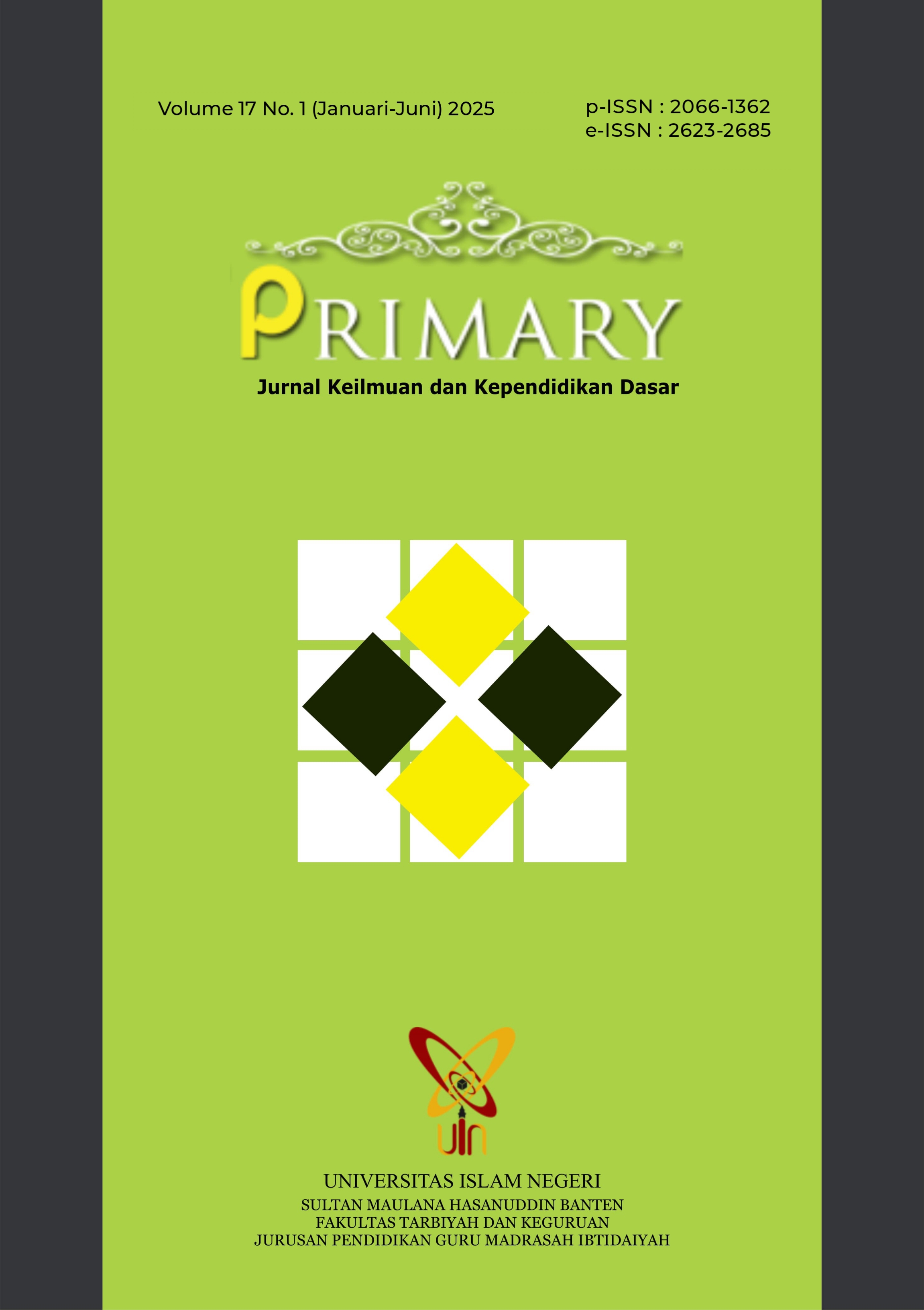Sekolah Ramah Anak Dalam Mencegah Perilaku Bullying di Sekolah Dasar
 DOI:
DOI:
https://doi.org/10.32678/primary.v17i1.11473
 Abstract viewed : 255 times
|
Abstract viewed : 255 times
|  PDF downloaded : 217 times
PDF downloaded : 217 times
Keywords:
Child-friendly School, Bullying, Elementary Education, Inclusive Environment, School PolicyAbstract
Bullying remains a serious issue in elementary schools and has negative impacts on children's psychological and social development. To address this problem, the Child-Friendly School (SRA) Program is implemented to create a safe, comfortable, inclusive, and violence-free learning environment, while also ensuring the protection of children's rights. This study aims to analyze the implementation of the SRA program in preventing bullying behavior at Labschool Elementary School UPI Cibiru. This research employs a qualitative descriptive approach. Data collection techniques include in-depth interviews, direct observation, and document analysis. The research informants consist of the principal, teachers, students, and parents. The analysis focuses on three main aspects: (1) anti-bullying policy planning, (2) implementation of the SRA program, and (3) evaluation of the program’s impact on the school environment. The findings indicate that although cases of bullying still occur, the school has systematically implemented anti-bullying policies, provided teacher training, and actively involved parents and students. An empathetic approach grounded in Islamic values also supports the creation of a friendlier and safer school environment. Furthermore, the SRA program has proven effective in increasing awareness among all school members about the importance of bullying prevention. It can be concluded that the implementation of the Child-Friendly School program significantly contributes to bullying prevention efforts in elementary schools and promotes the creation of an inclusive learning environment centered on children's well-being
Downloads
References
Amanda, V., Wulandari, S., Wulandari, S., Nabila Syah, S., Andi Restari, Y., Atikah, S., Engkizar, E., Anwar, F., & Arifin, Z. (2020). Bentuk Dan Dampak Perilaku Bullying Terhadap Peserta Didik. Jurnal Kepemimpinan Dan Pengurusan Sekolah, 5(1), 1932. https://doi.org/10.34125/kp.v5i1.454
Aulannisa, A., & Mustika, D. (2024). Analisis Dampak Bullying terhadap Perilaku Sosial Emosional Siswa Sekolah Dasar. Jurnal Basicedu, 8(4), 24612472. https://doi.org/10.31004/basicedu.v8i4.7918
Azizah, A. N., Nuria Fitriawan, B. K., Muzhaffarah, N. S., Anisa, S. N., & Syanur, V. F. (2024). Implementasi Sekolah Ramah Anak Untuk Mewujudkan Perilaku Antikekerasan. Jurnal Penelitian Kebijakan Pendidikan, 16(2), 131144. https://doi.org/10.24832/jpkp.v16i2.801
Creswell, J. W. (2016). CN Poth Qualitative inquiry and research design: Choosing among five approaches. Shaw LC, Greene K, Santoyo D and J Robinson (Eds). Sage Publications, 5, 94.
Fiolanisa, S., Lestari, D., Prasasti, D. A., & Santoso, G. (2023). Hubungan Pendidikan Karakter dengan Pola Perilaku Siswa di Lingkungan Sekitar. Jurnal Pendidikan Transformatif (Jupetra), 2(2), 380390.
Giacolini, T. (2021). John Bowlby: From attachment to affective neuroscience. In Neuropsychoanalysis of the Inner Mind (pp. 63-81). Routledge. https://doi.org/10.4324/9781003198741-4
Lestari, S. (2017). Implementasi Sekolah Ramah Anak Di SD Negeri Ngupasan Yogyakarta (Doctoral dissertation, UIN SUNAN KALIJAGA YOGYAKARTA). http://digilib.uin-suka.ac.id/id/eprint/28634
Melinda, L. P., Warlizasusi, J., & Khair, U. (2021). Implementasi Program Sekolah Ramah Anak dalam Membentuk Budaya Sekolah di MIS GUPPI 12 Lubuk Kembang (Doctoral dissertation, Institut Agama Islam Negeri Curup). http://e-theses.iaincurup.ac.id/id/eprint/1760
Mulyani, E. T., Wahyuningsih, S. L. D., Mursiti, E., Fauziati, E., & Sumardjoko, B. (2024). Integrasi teori pembelajaran sosial emosional pada kurikulum berbasis kearifan lokal untuk mencegah perilaku. 09. https://doi.org/https://doi.org/10.23969/jp.v9i04.21120
Olweus, D., & Limber, S. P. (2010). Bullying in school: Evaluation and dissemination of the olweus bullying prevention program. American Journal of Orthopsychiatry, 80(1), 124134. https://doi.org/10.1111/j.1939-0025.2010.01015.x
Rosalin, L. N. (2015). Panduan Sekolah Ramah Anak. Kementerian Pemberdayaan Perempuan Dan Perlindungan Anak, 42.
Schott, R. M. (2014). The social concept of bullying: Philosophical reflections on definitions. School bullying: New theories in context, 21-46.
Sugiyono, S. (2007). Metode penelitian kualitatif, kuantitatif, dan R&D. Bandung Alf.
Suparman, U. (2020). Bagaimana menganalisis data kualitatif. Bandarlampung: Pusaka Media.
Tarsono, T. (2018). Implikasi Teori Belajar Sosial (Social Learning Theory) Dari Albert Bandura Dalam Bimbingan Dan Konseling. Psympathic : Jurnal Ilmiah Psikologi, 3(1), 2936. https://doi.org/10.15575/psy.v3i1.2174
Usan. (2021). Sekolah Ramah Anak Upaya Meminimalisir Perilaku Bullying. Yogyakarta : Penerbit Deepublish, 2021 Copyright 2021 by Deepublish Publisher.
Yosada, K. R., & Kurniati, A. (2019). Menciptakan Sekolah Ramah Anak. JURNAL PENDIDIKAN DASAR PERKHASA: Jurnal Penelitian Pendidikan Dasar, 5(2), 145154. https://doi.org/10.31932/jpdp.v5i2.480
Downloads
Published
How to Cite
Issue
Section
License
Copyright (c) 2025 Annisa Nur Khoiriyah, Dadan F. Ramadhan, Muhammad Sofyan

This work is licensed under a Creative Commons Attribution-NonCommercial-ShareAlike 4.0 International License.
PRIMARY JOURNAL: https://ftk.uinbanten.ac.id/journals/index.php/primaryis licensed under aCreative Commons Attribution-ShareAlike 4.0 International License
An author who publishes in PRIMARY: Jurnal Keilmuan dan Kependidikan Dasar agrees to the following terms:
- The author retains the copyright and grants the journal the right of first publication of the work simultaneously licensed under the Creative Commons Attribution-ShareAlike 4.0 License that allows others to share the work with an acknowledgement of the work's authorship and initial publication in this journal
- The author can enter into separate, additional contractual arrangements for the non-exclusive distribution of the journal's published version of the work (e.g., post it to an institutional repository or publish it in a book) with the acknowledgement of its initial publication in this journal.
- The author is permitted and encouraged to post his/her work online (e.g., in institutional repositories or on their website) before and during the submission process, as it can lead to productive exchanges, as well as earlier and greater citation of the published work (See The Effect of Open Access).
The names and email addresses entered in this journal site will be used exclusively for the stated purposes of this journal and will not be made available for any other purpose or to any other party.










